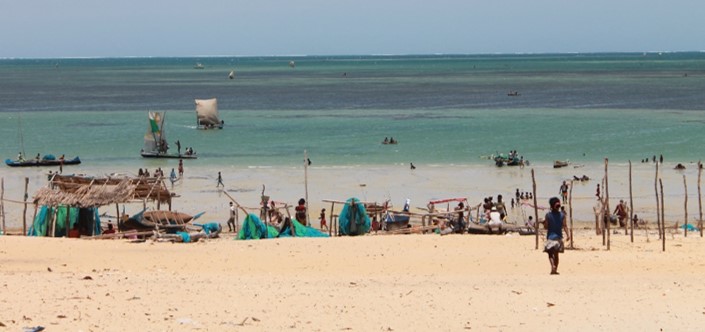Bay of Ranobe
Toliara Province, South-West Madagascar
The Bay of Ranobe, in southwest Madagascar, consists of 13 villages with populations ranging from roughly 1,000 to 10,000 people. Enclosed by a 32 km barrier reef, these communities rely on the Bay’s marine natural resources, primarily through fishing activities. Population increase, coastal migration, drought, and increased sedimentation have contributed to ecological degradation and marine resource depletion, but the community is taking action to address these problems.
Top environmental challenge faced by the community (currently or in the past 10 years):
The top environmental challenge in the area and faced by the community is that of depleted marine natural resources, and ecological degradation.Various factors have contributed to the current ecological state of the area most notably population increase and coastal migration, drought, and increased sedimentation due to clear-cutting timber for agricultural in in-land regions.
How the environmental challenge has affected local livelihoods:
The local community exists almost entirely on marine resources obtained from fishing and reef gleaning. Due to limited alternative livelihood opportunities, a lack of education, failed agriculture in-land, and population increase, pressure on these resources has increased.
Community response to the challenge, through environmental stewardship (conservation) initiatives that improve environmental well-being and support sustainable livelihoods:
With the support of UK-based non-governmental organisation ReefDoctor (see www.reefdoctor.org), the community established a community-managed marine protected area named Massif des Roses (i.e. the Rose Garden - named after the predominate foliose corals) in the southern region of the bay in 2007. The community, again with the support of ReefDoctor, formed a local fisher association called FIMIHARA (derived form the Malagasy phrase FIkambanana MIaro sy HAnasoa ny RAnomasina – translated to mean Association to Protect and Enhance the Marine Environment). FIMIHARA was legally recognised in April 2011, and incorporated into the community's local legal system. In 2009, a second community-managed marine protected area known as Ankaranjelita was established in the northern region of the bay. These protected areas are managed by FIMIHARA, with the support of partner organisations including ReefDoctor, private sector, the Institut Halieutique et des Sciences Marines (IHSM), at the University of Toliara, and the regional directorate of the Ministry of Fisheries. Both protected areas are patrolled by guardians which are employed by FIMIHARA. In addition, ReefDoctor, together with the community, has initiated several alternative livelihood programs, mostly focused on aquaculture of sea cucumbers and sea weed. Comparison of underwater visual surveys conducted by ReefDoctor show increases in average fish density for many of the predominate fish groups, however, fishers are unanimous in describing consistently low catches, especially when compared to the recent past. Ticket sales derived from tourist entrance fees have made a valuable contribution to running costs of FIMIHARA, including wages of the guardians, however, many community members still perceive a lack of tangible benefits from the establishment of the protected areas or aquaculture projects.
Extent to which governmental policy (at local, regional or national levels, as relevant) has supported, or been contrary to, the community's responses to the environmental challenge:
Both protected areas have been recognised as community managed reserves under a temporary protection status by the Direction Régionale du Développement Rural ( Ministère de l’Agriculture, de l’Elevage et de la Pêche). The national legislation which legally enables communities to establish and manage Locally Managed Marine Areas (LMMAs) is currently in its draft format. The passing of this legislation will represent a major step forward for legal recognition of the conservation efforts of these community conservation initiatives.
Keywords: Ecosystem
Coastal, Mangrove, Marine
Keywords: Resources
Fish
Keywords: Big Issues
Biodiversity, Environmental law, Resource use
Keywords: Solutions
Ecological Restoration, Governance/Management, Protected areas
Contributed by: Wayne Stanley Rice, University of Cape Town
The information provided and opinions expressed above are the responsibility of the contributor and do not necessarily reflect the views and analysis of the Community Conservation Research Network (CCRN), nor those of all members of the community described.
For any questions or comments on Communities in Action, please contact us
here.



